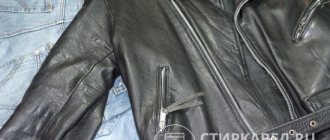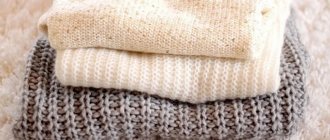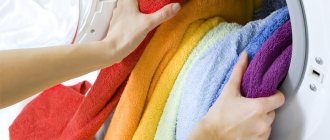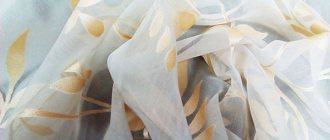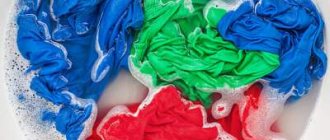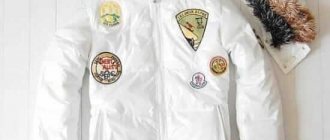Today, almost everyone wears knitwear. Warm and thin, elegant and baggy - it is equally adored by both fashionistas and people who are not very demanding when it comes to clothing. Admit it, can you also find a comfortable sweater or an elegant knitted dress in your closet? Therefore, many housewives will be interested in learning how to wash knitwear.
Soak
How to properly soak a dress or sweater? Thoroughly dilute the powder in cool water (knitwear shrinks in hot water). Make the soap solution more concentrated than you use during washing. Gently rub the contaminated areas with laundry soap and place the clothes in a basin with the solution. Leave for 20 minutes to allow the dirt to dry out. After soaking, you can begin the main wash.
Application area
Various items of men's, women's and children's clothing are made from noodles:
- sweaters;
- cardigans;
- pullovers;
- turtlenecks;
- T-shirts;
- dresses;
- women's suits;
- pajamas and so on.
Since the material is very comfortable and fits the body well, it is also used to make sportswear. However, it is suitable not only for sewing independent products - you can often see elastic bands made from noodles on the necks, sleeves and belts of jackets.
Handwash
How to wash knitwear correctly? Of course, with your hands! And preferably in soft water (add a little baking soda to hard water). Turn the product inside out. To choose the correct temperature for washing, carefully study the label on the clothing. A knitted dress and other items containing 70% cotton can be washed at a temperature of 40°-50° C. If the fabric is synthetic, wash at a water temperature of 30-40° C. Another nuance: you need to wash it by gently squeezing and unclenching the fabric with your hands. This can only be done along the length, so as not to stretch the product. And don't rub!
Rinse items in water at the same temperature as when you washed them. Try to rinse the detergent thoroughly. You can add antistatic conditioner to the second water.
After rinsing, do not twist! In Soviet times, resourceful housewives carefully placed a blouse or dress in a “string bag” and hung it over the bathtub or on the balcony. When the water had completely drained, things were laid out on a towel and changed from time to time for a dry one.
Characteristics and composition
The peculiar rib characteristic of noodles is created thanks to a special structure - during knitting, purl and target loops alternate. This is a soft and elastic material that stretches well and fits the figure.
The composition of the yarn can be different - wool, cotton, viscose, acrylic, polyester, polyamide, elastane and other artificial or natural materials are used.
The material lends itself well to dyeing and retains its color for a long time, despite exposure to sunlight, water and laundry detergents. The noodles do not wrinkle, they practically do not stretch and do not shrink over time.
Drying
Delicate items require more than just careful washing. They need to be dried properly. When trying to dry something quickly, do not forget about safety precautions and the specifics of the fabric.
Rules:
- Do not dry near open fire.
- Do not hang near heating devices or near radiators. Accelerated drying leads to deformation.
- Limit exposure to ultraviolet radiation. The fabric shrinks and fades.
- Dry knitted clothes on a towel. When it gets wet, change it to something else.
- You can’t hang it on a clothesline, it will stretch.
- You can use hangers for sweaters and dresses. The trempel must match the size of the item, otherwise the product will be deformed.
In an emergency, you can use an electric dryer and hang things next to the oven that is on. It is allowed to use a hairdryer, holding it at a distance of 20 cm from the item.
When should you go to dry cleaning?
You should contact a dry cleaner if you cannot get rid of dirt at home . Most often, professionals are trusted with valuable items, such as wedding dresses, items made of suede and genuine leather.
Dry cleaners that value their reputation never require advance payment. They warn the client in advance about possible consequences, since some stains cannot be dealt with even with the use of professional household chemicals.
Such organizations have existed on the market for a long time, so they have many positive reviews. The cost of the dress washing service depends on the complexity of the task. Prices start from 600 rubles and above.
Advantages and disadvantages
Advantages of knitted noodles:
- this material has a simple and natural, but at the same time effective appearance;
- due to its softness and elasticity it is very comfortable;
- the noodles hold their shape well;
- the material does not fade due to the action of water and detergents;
- clothes made from noodles are slimming due to the presence of pronounced vertical stripes;
- knitwear breathes well, providing comfort;
- noodles also easily absorb moisture, removing it from the body.
The negative properties of noodles include the fact that due to the high elasticity and stretchability of this material, over time, products made from it begin to lose shape.
Important Tips
To wash your dress successfully, you must follow the following recommendations:
- Before cleaning, turn the product inside out;
- do not use products containing bleaching components for black and colored items;
- preference should be given to liquid detergents;
- Do not wash white and colored items together.
The first time you wash the product carefully, observing all safety precautions.
You will find maximum useful information about washing clothes and various fabric products here.
How to wash away your fears | Knotty boy
Step 1 {Lather}
Unpack your Dread Shampoo Bar or open your liquid shampoo, inhale the icy aroma, strip down and jump into the tub.
Wet your scalp and strands, and if you are using a barbell , wet it too. It gets very foamy, so either spread your palms into a nice thick lather and rub it over your scalp, or you can rub the attachment directly onto your scalp between the strands and work up the lather that way. (Some people like to use the corner of the panel to get rid of itchy spots. Minty nice , Truth?)
If you are using liquid shampoo, pour a small amount into the palm of your hand and distribute evenly over the scalp, using more if necessary. Remember, you won't get a ton of foam, but it still works!
Step 3 {Rinse and repeat}
Rinse, allowing the shampoo to flow through your dreadlocks, thereby cleaning them without handling them too much. This is the best way to clean your new, still soft locks without damaging all that hard work you put into them.
Repeat shampooing and rinsing if necessary. You will be able to feel how clean your scalp is after rinsing and where you need to reapply shampoo.
Step 4 {Drying}
The last step of the process is just as important as the rest - drying. It's critical that your dreadlocks dry completely after each wash to prevent that musty wet dog smell.
Gently squeeze out as much water as possible with the towel (some of us like to alternate between flapping the locks to our favorite metal tune with the squeezing part of the towel to get as much water out as possible). Air drying your locks is fine, but if they get wet more than once a week, it's also worth investing in a hairdryer and using it on Low to speed up the process.
Finish with a little Knotty Boy Locksteady Tropical Strengthening Gel (not wax, in case there's still moisture in there!) to bring those flyaways and frizz back into place and give the lock a stronger grip.
Et voila! Spotlessly clean, well-maintained, salon locks that you made yourself right in your own home!
How often should I wash my dreadlocks?
We recommend once a week. But that doesn't mean you can't shower as often as you want. Just throw on one of our extra large dreadlock shower caps!
I wash my dreadlocks every day, but they smell terrible! What am I doing wrong?
As we've seen in this guide, washing locks is a really great idea, but you, Knobby friend, may be dealing with "too much of a good thing"! Your dreadlocks smell bad for a very simple reason: they don't dry completely between washes. The dreadlocks need to dry 100% halfway through before you get them wet again. This is especially important if they are new and you are still applying wax, as the wax can trap moisture inside the lock, leaving you with a nice, unpleasant musty odor if they are not dried first.
But don't be afraid! To get rid of the stink, thoroughly wash your locks with Knotty Boy Dread Shampoo again (these antifungal, antibacterial essential oils are very important for killing mildew), and then blow dry it on low or sit in the sun until it's completely dry, inside and out. You can usually just air dry your strands, but this will be the key to getting it completely dry as quickly as possible. From now on, try to stick to a washing schedule of only once a week.
Knotty Boy Peppermint Cooling Moisture Spray can provide significant relief from itchy scalps between washes, while Natural MISTics Lock Refresher & Fragrance Sprays are shampoo-free cleansers that kill odor-causing bacteria on contact. and give your curls a wonderful, long-lasting scent when they need a little pick-me-up.
My itchy scalp is driving me crazy!
Everyone has experienced an itchy scalp or dandruff at one time or another. This is fine. Anything from changing your shampoo to swimming in a chlorinated pool can do this to you. Nothing special, except that it can be very uncomfortable, and it is especially difficult to deal with when you have fears. Check out our helpful Dreadlock Care Tutorial for all the tips and tricks you need to combat the itch.
.
Care instructions
Caring for noodle products is easy; they can be washed at temperatures up to 40 degrees. In this case, it is better to use the delicate or manual mode. To give things extra softness, you need to add conditioner to the powder.
Clothes made from noodles should not be twisted during the spin cycle, nor should they be dried on a hanger. After washing, it is recommended to gently squeeze it out without twisting it, and then lay it on a horizontal surface and leave it until completely dry.
Such knitwear should be ironed carefully, from the wrong side, and if possible, with plenty of steam.
Noodle items should be stored on shelves. You should not leave them on hangers - in this case, the clothes can quickly stretch out, losing their original appearance.
How to wash knitwear
This is a rather demanding material when it comes to detergents. Laundry soap is best. You can grate it or just rub it vigorously with your hands in water. Most often it is used in the following proportion: 2 g of finished chips are diluted in 1 liter of water. That is, for a 10 liter basin you will need 20 g of laundry soap.
In addition, you can use washing powder for delicate fabrics or washing gel. Knitwear also has a positive relationship with regular hair shampoo.
Asian noodle salad | FeelGoodFoodie
This bright and colorful Asian noodle salad is a gluten-free vegetarian dish filled with fresh vegetables and tossed in a tangy, creamy, nutty dressing.
Cooking time: 20 minutes
Cooking time: 5 minutes
4 servings
January 15, 2021
This is an Asian noodle salad where all the hype isn't the noodles, but the tangy, creamy peanut dressing I make with them. This is an easy salad that can be made ahead. In fact, I recommend making it ahead of time! It's basically noodles soaked in said dressing and tossed with crunchy, colorful vegetables. This is one salad that you can actually eat as a complete lunch or dinner . The best part is that it is gluten free since it is made from rice noodles and it is completely vegan !
Healthy Noodle Salad Recipe
This Vegan Gluten Free Noodle Salad with Asian Dressing is a delicious dish that's full of color, flavor, and nutrition . I haven't found anyone who doesn't enjoy eating the salad when I make it. And I love that it's versatile, so you can use any noodles you want, any veggies you like, and even add a little protein of your choice to make it even more filling.
How to Make Asian Noodle Salad
The salad consists of three stages: 1) cooking vegetables, 2) preparing noodles, 3) preparing dressing. Each step will take you about 5 minutes. So everything turns out quite easily and quickly. For vegetables I use red peppers and carrots. Sometimes I even add red cabbage, sugar snap peas or broccoli. I recommend julienne cutting them if you can, or spiralizing any vegetables you can because it makes for a great presentation!
For the noodles, you can really use any noodle you want, including soba noodles, buckwheat noodles, or even spaghetti and linguine. I usually go to the Asian section of the grocery store and look for fried noodles. Most of them are rice based and the only ingredients are rice flour and water. This is what I chose for this Asian noodle salad. This is because it is gluten free, making it easier to eat. In addition, its texture absorbs the dressing very well without making it soft .
The great thing about these rice noodles is that you can place them in a saucepan with a large bowl, soak them in boiling water and just let them sit without heat for a few minutes until the texture softens. Only boiling water cooks them. I recommend stirring frequently to prevent the noodles from sticking together.
In a few minutes they will look like this and you can throw them:
How to make Asian salad dressing
The dressing uses common ingredients found in Asian blends. French fries, but vinegar plays an important role in imparting a tangy flavor to the dressing. I also use peanut butter to thicken it and give it a creamy, nutty flavor. Other ingredients: soy sauce, sriracha, olive oil, ginger, garlic and sugar (optional). You can whip everything up. But I prefer to use a tiny blender to crush the garlic and ginger and blend their flavors.
You might want to double this dressing because you can use it as a marinade for chicken, fish, or beef later in the week, or make an Asian noodle salad as well!
Once all three parts of the recipe are prepared, it's time to mix everything together .
You may find that the amount of sauce is too much for the noodles. Or you may be like me and find it just perfect because every noodle will literally be drenched in the creamy peanut dressing. And that's great for me!
I love how each ingredient in the dressing plays an important role in rounding out the flavor and making it irresistible. I mean, if nothing else, just do the bandage, guys!
Then just give it a good stir and taste. You can make it saltier by adding more soy sauce, nuttier by adding more peanut butter, or spicier by adding sriracha.
Tips for Making Asian Noodle Salad
- Do not rinse rice noodles or any other noodles you use with cold water after cooking them. This is because warm pasta absorbs the dressing better than pasta that has been rinsed in cold water. This is actually a great tip for any pasta salad you make!
- Let the salad sit for best taste. The great thing about the noodles we use is that they don't get soggy but continue to absorb the flavor of the dressing and get better as they sit. This makes this salad perfect for lunch, picnic or dinner. No need to bring a bandage with you!
- Add moisture to the salad after 3-4 days , reserving some of the dressing for later. Or you can whisk rice vinegar and soy sauce together to add moisture to the salad if it's drying out.
FAQ
Can you make Asian Noodle Salad ahead of time?
You can make the dressing a day or 30 days ahead and refrigerate it. Store leftovers in an airtight container. In the refrigerator they will last for 3-4 days. And because I used rice noodles, they held their texture really well for days even after I added the dressing.
How spicy is this salad?
The salad itself is not spicy; the heat in this dish comes from the dressing. If you prefer a mild dish, you can skip or reduce the amount of sriracha. To make it spicier, add more sriracha or chopped red chili peppers.
Is this salad healthy?
This salad is loaded with fresh vegetables and has about 330 calories per serving, making it a great lunch or dinner option. It's vegan, so it's saturated fat-free and gluten-free.
For more salad recipes, visit:
Asian Noodle Salad recipe or any other recipe on FeelGoodFoodie then don't forget to rate the recipe and leave me a comment below! I'd love to hear about your experience making this. And if you took some pictures, please share with me on Instagram so I can reblog my stories!
I first created this blog post on May 11, 2021. I'm updating it today to include improved new step-by-step images and a video tutorial!
Asian noodle salad
This bright and colorful Asian noodle salad is a gluten-free vegetarian dish filled with fresh vegetables and tossed in a spicy, creamy, nutty dressing.
.
